For a meal fit for a king, start by exploring the wide array of rich flavors that characterized medieval aristocratic tables. Ingredients such as saffron, almonds, and exotic spices like cinnamon were common and reflected the wealth of the medieval upper class. Kings and nobles indulged in lavish feasts, often featuring game meats such as venison, wild boar, and various types of fowl. These dishes were not only rich in flavor but also visually extravagant, often decorated with edible gold leaf and presented in elaborate forms. To recreate such a meal, consider starting with a creamy almond milk pottage infused with aromatic spices, followed by a roasted peacock dish, meticulously reconstructed using period recipes.
On the other hand, if you wish to experience the life of a medieval peasant, simplicity and accessibility of ingredients are key. Peasants’ diets were based on locally grown produce and staples such as barley, oats, and rye. Bread was a central part of the diet, often accompanied by pottage made from a variety of seasonal vegetables. Pulses and legumes, such as beans and peas, provided necessary protein. To cook like a peasant, try crafting a hearty stew using root vegetables like turnips and carrots, seasoned with wild herbs, for an authentic taste of everyday medieval life.
The contrast between the diets of peasants and kings was stark, yet both offer unique culinary experiences that hint at the richness and diversity of medieval gastronomy. By understanding and respecting the available resources and culinary practices of the period, you can transport yourself back in time and savor the tastes that shaped households across Europe. Whether you aim for regal decadence or the simple nourishment of the common folk, medieval food recipes unlock a world brimming with historical flavors and cooking techniques, ready for modern kitchens to explore.
Recreating the Rustic Flavor: Cooking Like a Medieval Peasant

Begin with simple, staple ingredients like barley, oats, and rye, which form the core of a peasant’s diet. These grains can be transformed into porridge, a nourishing and versatile dish. To make it authentic, cook the grains slowly with water or milk, adding a pinch of salt. Enhance flavor with a few wild herbs or a drizzle of honey if available.
Season your meals with accessible herbs such as parsley, dill, and chives. Grow them in small kitchen gardens for fresh supply. These herbs not only add flavor but also provide essential nutrients to complement the limited diet.
Preserve meats through salting or smoking, techniques commonly used to store food throughout winter months when fresh supplies were scarce. Pork and fish were typical choices, offering variety and sustenance during harsher seasons.
Utilize vegetables like turnips, cabbage, and leeks, which thrived in medieval gardens. Slowly simmer these with lentils or beans to create hearty stews. Such dishes are rich in fiber and could sustain peasants throughout their demanding workdays.
A blend of flavors from different ingredients can replicate the rustic charm of peasant cuisine. Ensure balanced portions of grains, legumes, and vegetables to deliver both sustenance and taste.
| Ingredient | Method |
|---|---|
| Barley | Slow-cooked in water; seasoned with herbs or honey |
| Pork | Salted or smoked for preservation |
| Turnips | Simmered with lentils in stew |
| Parsley | Freshly chopped; added for flavor and nutrition |
| Oats | Cooked into porridge with milk or water |
Choosing Ingredients Available to Peasants
Focus on root vegetables such as turnips, carrots, and parsnips, which were staple ingredients for peasants due to their nutritional value and storage capabilities. Grow these in your garden or purchase them from local farmers.
Incorporate grains like barley, oats, and rye, as they are affordable and versatile. Create simple porridges or breads by combining different grains for an authentic medieval experience.
Utilize legumes including peas, beans, and lentils, which are rich in protein and fiber. These were commonly eaten during meatless days and provided essential sustenance. Experiment with soups and stews, combining legumes with vegetables for hearty meals.
Rely on foraged greens such as nettles, dandelions, and sorrel to add flavor and nutrition to dishes. These are available in the wild and can be used in salads or as cooked side dishes, enhancing your meal with historical authenticity.
Gather berries and nuts when available in the environment. Berries like blackberries and elderberries can be used fresh or preserved, while nuts such as hazelnuts add a crunchy texture to dishes.
Explore honey as a sweetener, as it was more accessible than imported sugars. Use it sparingly to sweeten porridges or in small treats, creating a natural sweetness in your medieval-inspired recipes.
Simplify your meals with a focus on these humble yet nourishing ingredients, reflecting the practical and resourceful eating habits of medieval peasants.
Simple Cooking Techniques for a Rustic Experience
For an authentic medieval cooking experience, embrace basic techniques using minimal tools and natural resources. Begin by considering the humble hearth as your primary cooking space.
- Open Fire Roasting: Use skewers or spits to roast meats and vegetables over an open fire. Maintain a steady fire with dry wood for consistent heat. Turn the skewers regularly to prevent charring and ensure even cooking.
- Clay Pot Baking: Opt for unglazed clay pots to simmer stews and soups. These retain heat well and add an earthy flavor. Place the pot near embers, allowing contents to slow-cook and develop rich tastes over hours.
- Herb Infusions: Flavor dishes with fresh, foraged herbs. Crush or finely chop herbs prior to cooking to release natural oils. Wrap herbs in cheesecloth and immerse them in broths for subtle infusions.
- Stone-ground Grains: Use a mortar and pestle for grinding grains like barley or oats. The coarse texture enhances the rustic feel and flavor when making breads and porridges.
- Pottage Creation: Combine whatever seasonal vegetables and grains are available. Simmer together in a single pot, occasionally stirring, to create a hearty, nutritious meal.
- Pickling and Fermentation: Preserve vegetables by fermenting them in a simple brine. This adds depth of flavor and nutritional value while allowing ingredients to last through harsher seasons.
Experimenting with these methods cultivates a deep connection with traditional culinary practices, offering an immersive taste of the past.
Common Dishes on a Peasant’s Table
Explore the essentials of peasant cuisine by experimenting with these simple yet nourishing dishes that were staples in medieval times. These recipes highlight the resourcefulness of peasants, making the most of available ingredients.
| Dish | Ingredients | Description |
|---|---|---|
| Pottage | Barley, root vegetables, herbs | A versatile, hearty stew made by simmering grains and vegetables, often seasoned with herbs. Perfect for utilizing leftovers and minimizing waste. |
| Rye Bread | Rye flour, water, salt, sourdough starter | This dense bread was a staple, offering sustenance and calories. Its long shelf-life meant it was baked in large loaves to last. |
| Onion and Leek Soup | Onions, leeks, garlic, broth | A simple soup using available vegetables, cooked slowly to enhance flavor, offering warmth on cold days. Serve with rye bread for a complete meal. |
| Barley Gruel | Barley, milk or water, honey | A basic, nutritious porridge often eaten for breakfast. It provided energy and could be sweetened with honey for taste. |
| Scrambled Eggs with Herbs | Eggs, parsley, chives | Chickens were common on peasant farms, and using fresh herbs from the garden made this a favored meal, especially in the spring and summer. |
To appreciate the rustic flavors fully, cook these meals over an open flame whenever possible. Using rudimentary tools and methods provides a practical insight into the lives of medieval peasants, bringing history alive through the senses.
Porridge and Bread: Staples of a Peasant Diet
Explore the simplicity and nourishment of medieval peasant staples by focusing on porridge and bread, both essential to daily life. Begin your preparation of porridge by gathering basic grains like barley, oats, or rye–whichever is available. Boil the grains in water or milk and add a pinch of salt to enhance the flavor. Stir continuously to achieve a smooth texture, then serve it warm. Try adding herbs or a splash of honey for flavor variations.
For bread, utilize coarsely ground whole grains mixed with water to form a basic dough. Consider adding some salt for taste. Knead the dough until it is smooth, then allow it to rise in a warm spot. Bread in medieval times often relied on natural yeasts from the air, so patience is key. For baking, use a simple wood-fired oven or a modern oven preheated to replicate rustic cooking methods. The result is a dense, nourishing loaf that’s excellent with a smear of butter or cheese.
Both porridge and bread offer insight into peasant resilience and resourcefulness, showing how these humble foods sustained entire communities by providing energy and sustenance.
Savoring Opulence: Cooking Like a Medieval King

Indulge in the richness of medieval feasts by preparing a lavish dish that would grace a royal banquet. Begin with a sumptuous roast swan or peacock, traditional dishes for medieval nobility. Opt for high-quality game birds and season generously with aromatic spices such as cinnamon, cloves, and mace to encapsulate the opulence of the era.
To accompany this centerpiece, serve a creamy almond milk porridge. Simmer almond milk with rice or barley, sweetening gently with honey. This dish, beloved by the elite, highlights wealth through the use of imported and costly ingredients like almonds and spices.
Create an elaborate pie, such as a ‘coffyn’, which contains layered meats and fruits. Use rich ingredients, including minced pork, beef, or fish, seasoned with saffron and other spices. Bake within a sturdy crust to lock in juices and flavors, presenting a golden, aromatic delight once served.
No king’s table is complete without a wide selection of mead and ale. Brewed from honey, grains, and herbs, these beverages symbolize the prosperity and grandiosity of medieval courts. Serve in ornately carved goblets to enhance the authentic regal atmosphere.
To conclude the feast, offer a decadent dessert like spiced fruit tarts or custard infused with rosewater. These desserts not only refresh the palate but also reflect medieval European royalty’s penchant for sweetness balanced with aromatic florals.
Royal Ingredients: What Made a Meal Fit for a King
Serve the richness of medieval royalty on your table with a selection of ingredients that defined an extravagant feast. While peasants subsisted on simple grains and vegetables, kings enjoyed luxurious meals brimming with imported delicacies and rare spices. Start by sourcing the finest elements that would have consistently graced royal tables in the Middle Ages.
- Exotic Spices: Cloves, nutmeg, ginger, and especially black pepper were highly prized. These spices not only added flavor but also served as status symbols, reflecting immense wealth and reach.
- Rare Meats: Peacocks, swans, and venison were staples of royal banquets. Conservative cuts, such as pig snouts and chicken feet, were left for the lower classes.
- Luxurious Fish: Freshwater species like pike and carp featured prominently, loved for their flavor and the challenge of their out-of-season procurement.
- Imported Fruits and Nuts: Figs, dates, and almonds from far-off lands delighted palates with their sweetness and appeal.
- Honey and Sugar: Used as sweeteners in an era before refined sugar became commonplace, these ingredients were treasured for confectioneries and sweet dishes.
- Rich Dairy: Cream, butter, and cheese provided depth and richness to meals, showcasing the opulence of those who could afford surplus dairy farming.
- Saffron: This vibrant spice not only infused dishes with color but also marked culinary luxury distinctive to regal courts.
Craft menus fit for a king by integrating these elements, creating a memorable feast reminiscent of times when meals were much more than sustenance–they were displays of power, wealth, and influence.
Intricate Cooking Techniques of the Royal Kitchen
Explore the art of spit-roasting, a hallmark of royal kitchens. Adjust both the speed and altitude of the spit to ensure thorough cooking and mouth-watering caramelization. Master the timing by rotating meats at an optimal pace for even browning.
Elevate flavors with the subtle use of aromatic infusions. Create oil blends using rosemary, thyme, and other herbs to impart nuanced tastes to dishes served at the royal table. Heat the oils gently to release the full bouquet of aromas, then incorporate them into sauces or drizzles for meats.
Engage in the crafting of ornate pies using layers of savory and sweet fillings. Embed intricate pastry work design to convey both status and culinary mastery. Incorporate a variety of ingredients from ground meats to seasonal fruits for a complex flavor profile that satisfies all palates.
Master the art of subtle seasoning, balancing spices and salts to highlight each main ingredient without overpowering them. For example, the judicious use of imported spices like saffron or pepper can transform a dish from simple to regal, offering layers of taste with every bite.
Participate in meticulously planned banquets, where presentation rivals taste. Use edible flowers and gilded garnishes to add opulence to the meals, carefully arranging each component for visual allure.
Refine your ability in slow cooking methods, such as braising, to enhance tenderness and depth of flavor. By simmering meats in liquid for extended periods, achieve meltingly tender results, allowing the spices and herbs to infuse thoroughly.
Feasting Dishes: Recipes from a King’s Banquet
Begin with a flavorful roasted peacock, a regal choice once reserved for the nobility. Prepare by carefully plucking and cleaning the bird, then marinating it with a mixture of cloves, black pepper, and red wine. Roast the peacock in a preheated oven at 375°F (190°C) until the skin is golden and the meat is tender and juicy. Serve it with a garland of fresh herbs for an authentic medieval presentation.
Next, try a hearty venison stew, a favorite of kings and queens. Cube the venison and brown it in a large pot with onions and garlic. Add in chopped carrots, parsnips, and leeks for depth of flavor. Pour in a generous amount of beef broth and red wine, then season with thyme, bay leaves, and a pinch of nutmeg. Simmer slowly until the meat is tender, then serve with chunks of rustic bread to soak up the rich broth.
No royal banquet is complete without a sweet finish. Serve a pear tart in almond crust, a dessert fit for royalty. Peel and slice ripe pears, then toss them in honey and a touch of cinnamon. Lay the pears over an almond-flour crust and bake until golden. The result is a dessert that pairs beautifully with a scoop of cream.
To drink, offer a spiced wine, known as hypocras, that was often enjoyed by the elite. Combine red wine with cinnamon, ginger, nutmeg, and sugar, then gently heat to allow the flavors to meld. Serve it warm to fully appreciate its aromatic complexity.
These dishes capture the essence of a king’s feast, delivering a culinary experience that’s as rich in tradition as it is in flavor. With authentic ingredients and thoughtful preparation, you can recreate the grandeur of medieval dining in your own home.
Wine and Spices: Luxuries of a King’s Table
Dive right into the world of medieval opulence by exploring wines and spices that graced a king’s table. When choosing wines, focus on those made from grape varieties historically popular with royalty, like Pinot Noir or Riesling, served in elegant goblets. Medieval feasts were incomplete without wine aged in oak barrels for a rich flavor.
- Wines:
- Pinot Noir: Known for its delicate and complex flavor, pairs splendidly with game meats.
- Riesling: Offers a range from sweet to dry, suitable for pairing with both savory dishes and desserts.
- Spices:
- Cinnamon: Imported from the Far East, often used in desserts and spiced wines.
- Cloves: Highly prized for their strong aroma, ideal for both meat dishes and mulled wine.
- Saffron: The most expensive spice, used sparingly to add color and luxury to rice dishes.
Incorporating these elements into your cooking brings an authentic taste of medieval luxury to your table. Highlight the pairing of rich meats with fragrant spices and carefully selected wines to emulate a regal dining experience.
Q&A:

Are the ingredients used in medieval recipes still available today, and where can I find them?
Yes, many ingredients used in medieval recipes are still available today, although some may be harder to find or may have slightly different qualities due to modern cultivation techniques. For common ingredients like grains, herbs, and meats, you can usually find them in local supermarkets or specialty grocery stores. For more unusual ingredients, such as spices that were highly prized in medieval times, you might need to visit specialty spice shops or online marketplaces that focus on historical or exotic products.
How difficult is it to prepare a medieval dish compared to modern recipes?
The difficulty of preparing a medieval dish can vary greatly depending on the specific recipe. Some medieval recipes require long cooking times and complex techniques that are not commonly used today, which might pose a challenge for modern cooks. Additionally, medieval instructions were often vague, assuming a certain level of culinary knowledge. However, with patience and practice, and by following modern adaptations of these recipes that provide clearer instructions, anyone can try their hand at replicating medieval dishes.
What are some typical flavors or spices used in medieval cuisine that might surprise a modern palate?
Medieval cuisine often used a combination of sweet and savory flavors that can be quite surprising to those accustomed to modern taste profiles. Common spices included cinnamon, cloves, mace, and ginger, which were used in both meat dishes and desserts. Additionally, ingredients such as verjuice (a sour juice made from unripe grapes), rose water, and almond milk were popular and lent a unique flavor to many dishes. This combination of spices and ingredients created a distinctive taste that some might find very different from contemporary culinary practices.
Why was bread such a staple in medieval diets, and how did it differ from bread today?
Bread was a staple in medieval diets largely due to its affordability and the ease with which it could be produced in large quantities. It was a primary source of sustenance, particularly for peasants. Medieval bread often differed from modern bread in texture and flavor, as it was typically heavier and coarser. This was due to the use of whole grains and less refined flours. Additionally, bread was sometimes flavored or enriched with ingredients like spices or herbs to improve its taste and nutritional value.
Can medieval recipes be adapted for contemporary dietary restrictions or preferences, such as vegetarianism?
Many medieval recipes can be adapted to suit contemporary dietary restrictions or preferences with some creativity. For instance, vegetable-based dishes or those that rely heavily on grains and legumes can be naturally vegetarian. In cases where meat is a primary ingredient, it can often be replaced with modern plant-based alternatives, or the recipe can be adjusted to highlight other flavors. It’s all about experimenting with substitutions while maintaining the essence of the original dish.
What are some typical ingredients used in medieval recipes, and are they still available today?
Medieval recipes often included ingredients like grains (barley, oats, wheat), meats (pork, beef, lamb), and root vegetables (turnips, carrots). Spices such as saffron, cloves, and cinnamon were also popular, especially among the wealthy. Many of these ingredients are still available today, though some, like certain heirloom grains and heritage varieties of vegetables, might be less common. You can find them in specialty stores or farmers’ markets.
How did the diet of a medieval peasant differ from that of a king?
The diet of a medieval peasant was typically much simpler and consisted mainly of bread, pottages (thick stews), and occasionally meat or fish if it was affordable. Peasants relied heavily on what they could grow or raise themselves. In contrast, a king’s diet was lavish and varied, featuring a wide array of meats, exotic spices, and imported goods. Meals were often elaborate affairs with multiple courses, showcasing the wealth and status of the royal household. Additionally, kings had access to fresh fruits and vegetables year-round, thanks to better storage facilities and trade.




